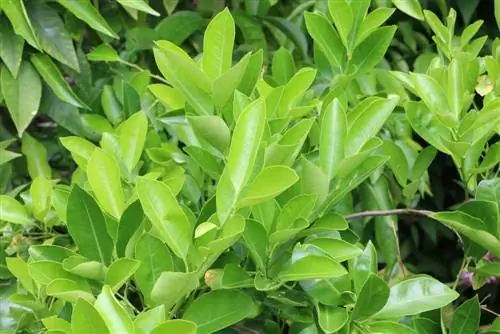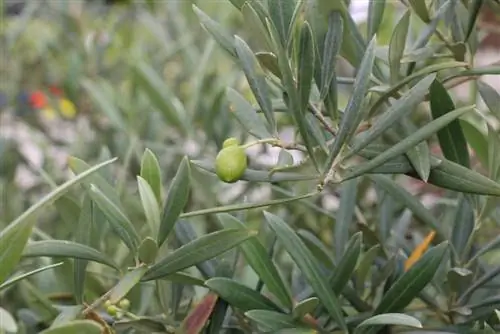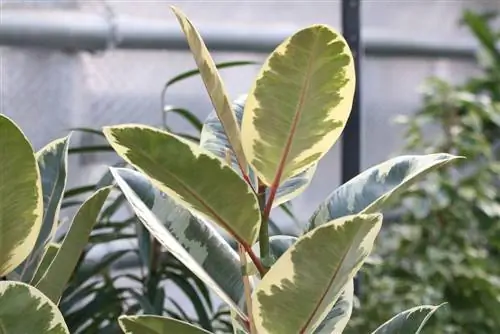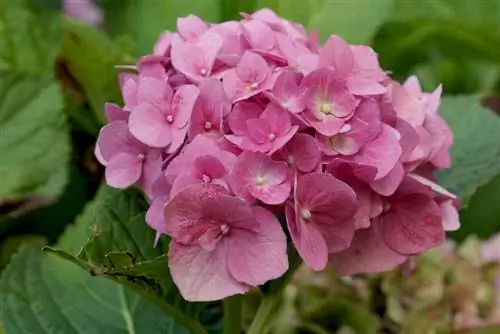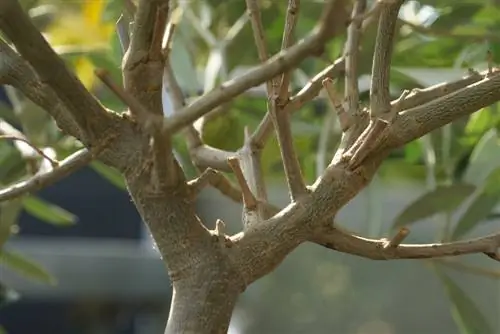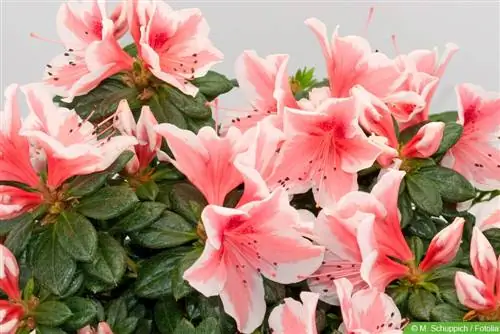- Author admin [email protected].
- Public 2023-12-17 03:39.
- Last modified 2025-01-24 12:45.
The kumquat tree occasionally sheds individual leaves and flowers. This has natural causes and is generally not a cause for further concern. However, if the loss of leaves increases, then the triggers should be examined closely. Especially when more than half of the leaves have already been shed and the bare branches are turning brown. To ensure that you can enjoy the exotic citrus tree for a long time, the temperature, lighting conditions, location and watering units play an important role.
Leaf loss
The kumquat tree regularly sheds individual leaves, this is a natural circumstance. If the tree loses a lot of its leaves in winter, then that is also a completely normal process. This serves to protect the plant as the metabolism is significantly reduced. Since far fewer nutrients are now absorbed, not as many nutrients can be consumed. At other times of the year, however, extreme leaf loss is an indication of deficiencies in cultivation. The size of the pot also plays an important role in he althy growth. If the roots begin to fill the entire planter, the kumquat tree will need a much larger container.
- Take countermeasures promptly if leaves are lost too much
- Watch the plant closely
- Analyze reasons and triggers
- Control care and location
- Check for diseases and pests
Pouring
If the kumquat tree loses a lot of leaves in the summer months, this is often due to incorrect watering. It is therefore important to check your own watering behavior. Too little water leads to leaf loss, but you shouldn't water too much either. In addition, the plant does not tolerate extremely calcareous irrigation water, although the lime value varies greatly from region to region. This value can be determined specifically using a test from a specialist retailer. Another reason for leaf loss can be low humidity levels. Due to its exotic origin, the citrus tree is used to high humidity.
- Plant needs plenty of water, especially during the growth phase
- Cannot cope with permanent waterlogging
- Damaged water in the plant pot leads to rotting roots
- Create a drainage layer and check the drain for blockages
- If tap water contains cold water, it is better to collect rainwater for watering
- Spray the plant carefully with lime-free water
- Alternatively, place a container filled with water nearby
Tip:
If you live in a region with very hot summer temperatures and low humidity, you can place the tree in a larger bucket filled with water during this time. However, on a raised platform so that the excess water can drain away completely and no waterlogging occurs.
Care errors

If you want the kumquat tree to produce lots of leaves and bloom profusely, then proper care is crucial. Particular attention should be paid to the quality of the substrate when planting, as the plant reacts very sensitively in this area. If the flowers develop poorly during the flowering period, do not open at all or fall off quickly, then the substrate often does not contain enough nutrients. Nutrient-rich soil is also required for a bountiful harvest, otherwise no fruit will grow. However, don't be surprised, the plant only bears fruit every two years.
- Extremely sensitive to limescale, both in irrigation water and in the soil
- Optimal pH value is in the acidic range
- Descale extremely cold tap water with water filters
- Extremely high nutrient requirements, fertilize at least every 2 weeks
- Fertilizer is ideal for citrus plants
- For abundant flowering, temporarily use fertilizer with lots of potassium
Location Error
If the kumquat tree is cultivated in the living space, then the orientation of the location is very important. The citrus plant comes from Asia and is therefore used to tropical temperatures with lots of sun. However, the double-glazed windows installed almost everywhere these days filter out many important light components, so that the plant is literally in the dark. A permanent lack of light leads to loss of leaves and flowers.
- Prefers warm and sunny living spaces
- Window sills facing west and south are ideal
- North and east windows are unsuitable
- Place the plant in front of the open window when the weather is good
- If available, bring to the balcony during the day
- It is essential to avoid drafts at the location, as this promotes pest infestation
- Brighten up places that are too dark with a plant lamp
Wintering
The kumquat tree is not used to the dark season and the associated lack of light in its homeland. These conditions are not well tolerated and often lead to severe leaf loss. The darker the location, the more leaves the ornamental shrub will lose. To prevent this, the site conditions during winter rest play an important role. If the heat-loving plant is cultivated in the garden, on the balcony or terrace, then it can usually tolerate the first and light frosts in autumn quite well. However, for the winter and at extremely low temperatures, the plant needs adequate winter quarters. Depending on the weather and the region, the kumquat tree can move outside again from May.
- Only partially hardy, has to move at the beginning of winter
- Choose the brightest possible location for winter quarters
- But requires cool temperatures to bloom again the following year
- Temperatures between 5-10° C are ideal for wintering
- Don’t place too close to the radiator
- Dark storage rooms, hallways and garages are unsuitable as winter locations
- Rarely used guest rooms and bright corridors are ideal
Tip:
During the winter break you should not fertilize and only water a little. In addition, the plant must be checked regularly for waterlogging, rotting roots, diseases and pests.
Conclusion
If the kumquat tree loses some leaves and flowers every now and then, then this is a completely natural process and nothing to worry about. However, there are often serious reasons behind extremely severe leaf loss. If these are not recognized and eliminated promptly, this can lead to the complete death of the plant. Therefore, the triggers for a massive shedding of leaves must always be investigated. In this way, suitable countermeasures can be initiated immediately. The reasons often include errors when watering; both too much and too little water is harmful to the plant. Kumquats cannot tolerate waterlogging at all; this leads to signs of rot on the roots and then to the leaves falling off. If the leaves, flowers and fruits develop only poorly or not at all, the reason for this is often that the nutrient content of the substrate is too low. Therefore, it is important to pay attention to regular fertilizer applications, especially during the flowering period. Due to its exotic origins, the plant prefers sunny locations with a lot of direct sunlight. Dark site conditions are not tolerated and also lead to leaf loss. In addition, the plant suffers from persistent drafts, temperatures that are too low in summer and humidity that is too low. However, in winter quarters, cool temperatures are desired in a bright location.

